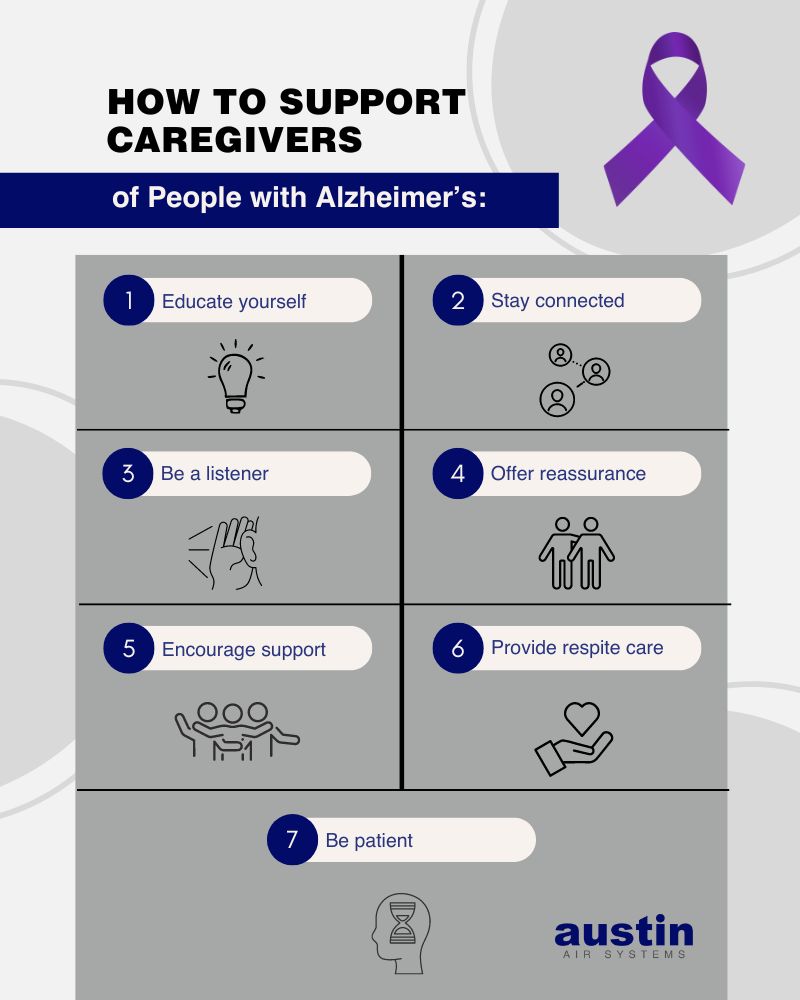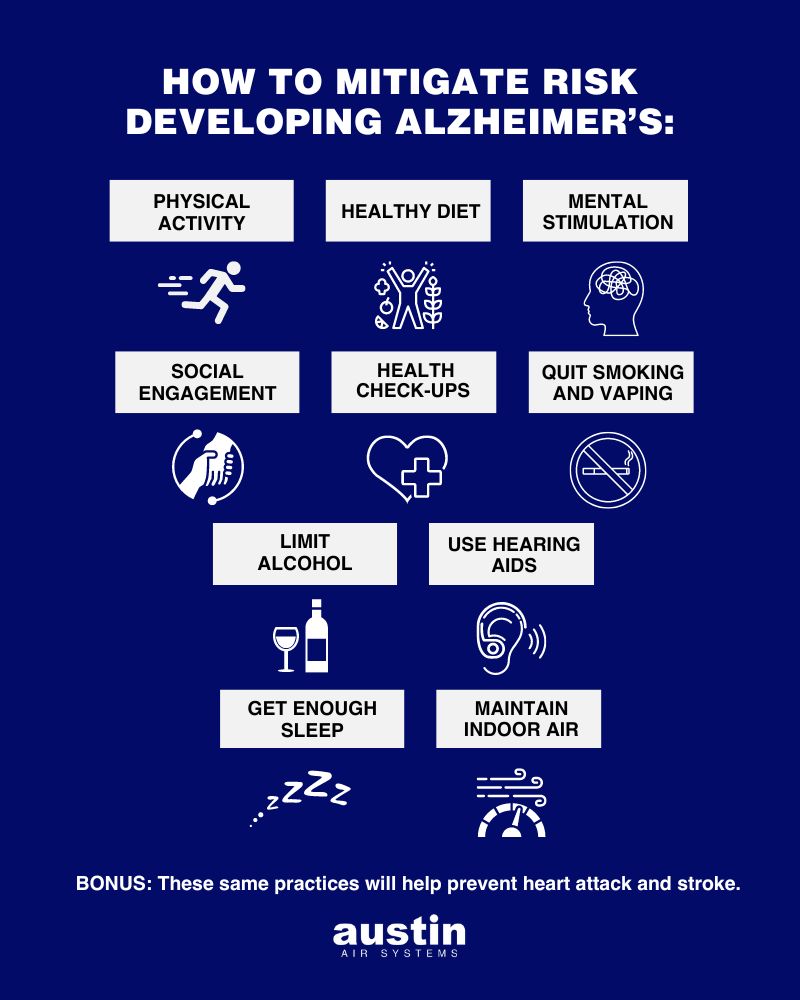June is Alzheimer’s and Brain Awareness Month, a time dedicated to raising awareness about Alzheimer’s disease and other dementias, and promoting the importance of brain health. As Alzheimer’s rates continue to rise globally, understanding how to support those affected and mitigate risks is crucial.
This blog post will provide insights into how you can support caregivers to someone with Alzheimer’s. There’s an estimated 6.5 million people with Alzheimer’s in the United States and according to the Alzheimer’s Association, “More than 11 million family members and other unpaid caregivers provided an estimated 16 billion hours of care to people with Alzheimer’s or other dementias in 2021.”1
With that in mind, we’re going to devote the bulk of this blog to advice on how to support caregivers. If you, dear reader, are a caregiver, we hope that this will be a gentle reminder of what you need for self-care. And of course, if you aren’t a caregiver yourself, it’s very likely you know and love someone who is taking care of an Alzheimer’s patient. Below we’ll discuss some extra ways you can provide them with much needed support.2
We’ll also explore ways to reduce your risk of developing Alzheimer’s and dementia, including the role of air purifiers in reducing exposure to air pollution.34
About Alzheimer’s Disease
Alzheimer’s disease is a neurological disorder that results in a range of cognitive, behavioral, and physical symptoms that worsen over time. The primary characteristic of Alzheimer’s disease is memory loss. One of the earliest and most prominent signs of Alzheimer’s is difficulty remembering recent events, conversations, or appointments. As the disease progresses, long-term memory can also be affected.
Alzheimer’s is the most common form of dementia.5 The decline in cognitive function also includes difficulty with problem-solving and planning, confusion with time or place, language problems, and poor judgment/decision-making.
There are also social/psychological symptoms that can prove to be challenging for people with Alzheimer’s and their caregivers. Alzheimer’s can cause significant mood swings and changes in personality. People may become confused, suspicious, depressed, fearful, or anxious.
Some individuals may also exhibit increased agitation, aggression, or irritability. This can be triggered by a variety of factors, including confusion, frustration, and environmental changes.
Due to the challenges they face, individuals may withdraw from social activities, hobbies, or work projects they once enjoyed. Understandably, many individuals experience depression and a loss of interest in activities. Sadly, this can cause someone to deteriorate more quickly.
Supporting Caregivers for Individuals with Alzheimer’s
Caring for someone with Alzheimer’s is a demanding and often emotional task. If this is you, we hope you’ll find the information outlined below helpful. (Maybe you’ll even consider sharing it with friends…)
And supporting someone who is a caregiver for a person with Alzheimer’s disease involves addressing their emotional, physical, and practical needs. Here are some of the best ways to offer support:
Educate Yourself: Learn about Alzheimer’s disease and its progression. Understanding what the caregiver is going through can help you provide more effective and empathetic support.
Maintain Social Connections: Help the caregiver stay connected with friends and family. Organize social activities that are manageable and enjoyable for both the caregiver and their loved one. Invite the caregiver to social events, even if they might decline. The invitation itself can make them feel valued and remembered.
Be a Good Listener: Caregivers often need someone to talk to about their experiences, frustrations, and fears. Simply being there to listen without judgment can provide significant emotional relief. Of course, anyone reading this is an excellent friend who always listens… but just consider this a reminder to give your friend space to share.
Offer Emotional Reassurance: Caregivers can feel isolated and overwhelmed. After you listen to them, reassure them that their feelings are normal and validate their hard work and dedication. They may also have feelings of resentment or anger at the situation, these are also healthy reactions.
Support Networks: Encourage caregivers to join support groups and seek professional help where possible. Sharing experiences and advice with others in similar situations can be incredibly beneficial and reduce feelings of isolation. Social workers, occupational therapists, and specialized doctors can also provide tailored advice and interventions.
Respite Care: Caregivers need breaks to maintain their well-being. Respite care services offer temporary relief and can help prevent burnout. If you can, give the caregiver a break by taking over their duties for a few hours or days. If you don’t feel comfortable stepping into the caregiver’s shoes (which is understandable), you can help them to arrange formal respite care services. You can also volunteer in other ways, like bringing them and their loved one meals or running some errands for them.
Be Patient with Routine and Structure: Understand that consistent schedules help people with Alzheimer’s to feel more secure and oriented. Therefore, any caregiver will likely have a set schedule too. Try to accommodate their schedule when making plans and be patient if they aren’t currently available or flexible like they once were.
Supporting someone who is a caregiver for a person with Alzheimer’s requires a multifaceted approach that addresses their emotional, practical, and social needs. By offering a listening ear, practical help, and emotional reassurance, you can make a significant difference in their ability to manage the demands of caregiving and maintain their own well-being. Remember, even small gestures of support can have a profound impact on a caregiver’s life, which is good for the person with Alzheimer’s too.
Mitigating Risks of Developing Alzheimer’s
This year’s awareness campaign centers around the hashtag #ENDALZ. There is no known, single cause for Alzheimer’s or cognitive decline. But recent studies have highlighted risk factors associated with the development of dementia. Addressing these risk factors can significantly reduce the prevalence of Alzheimer’s.
According to a ground-breaking, comprehensive study, the twelve key risk factors include: low education, hearing loss, traumatic brain injury, hypertension, excessive alcohol consumption, obesity, smoking, depression, social isolation, physical inactivity, diabetes, and air pollution.6
Here’s some known ways to prevent dementia and Alzheimer’s:
Physical Activity: Regular exercise is crucial. Aim for at least 150 minutes of moderate aerobic activity or 75 minutes of vigorous activity each week. Did you know cardiovascular health is closely linked to brain health? One more reason to get moving. Walking is one of the best forms of exercise and most people are able to do it!
Healthy Diet: A balanced diet rich in fruits, vegetables, whole grains, lean proteins, and healthy fats supports overall health and can reduce the risk of obesity, hypertension, and diabetes—all risk factors for Alzheimer’s. These are also risk factors for stroke and heart disease, so watch what you eat!
Mental Stimulation: Engage in activities that challenge the brain, such as puzzles, reading, or learning new skills. Lifelong learning and mental stimulation can help build cognitive reserves. If you’re a senior over the age of 60, you may be able to take classes for free at public community colleges and universities.
Social Engagement: Maintain strong social connections. Regular interaction with friends and family can reduce the risk of depression and social isolation, both linked to an increased risk of dementia. You can add socialization to your exercise with fitness classes, which get you moving and put you in touch with a community.
Regular Health Check-ups: Monitor and manage health conditions such as hypertension, diabetes, and high cholesterol. Early detection and treatment can mitigate the risk of cognitive decline. And also prevent stroke and heart attack.
Avoid Smoking and Limit Alcohol: Smoking cessation and moderating alcohol intake are vital steps in reducing the risk of Alzheimer’s. Add brain health to the long list of reasons to quit smoking.
Hearing Health: Address hearing loss early. Use hearing aids if necessary, as untreated hearing loss is associated with a higher risk of cognitive impairment. It’s unclear if hearing loss is an indicator that dementia may be developing or if the isolation from hearing loss contributes to Alzheimer’s but don’t resist the need for hearing aids, particularly if you’re at high risk for dementia due to genetic or lifestyle reasons.7
Air Quality: Emerging research has shown a significant link between air pollution and the risk of developing Alzheimer’s.8 Air pollutants, such as fine particulate matter (PM2.5), can contribute to neuroinflammation and oxidative stress, which are linked to cognitive decline.910
Air Purifiers: A Key Tool in Reducing Alzheimer’s Risk
One of the most effective ways to reduce exposure to air pollution indoors is by using an air purifier. Austin Air Purifiers, renowned for their Medical-Grade, high-efficiency particulate air (HEPA) and activated carbon filters, can capture harmful particles, including PM2.5, thus improving indoor air quality and decreasing one of the most significant risk factors associated with Alzheimer’s.
Investing in an Austin Air Purifier is a proactive step towards creating a healthier living environment and potentially reducing the risk of developing Alzheimer’s. Given the significant impact on dementia cases from air pollution, as highlighted in recent studies, improving air quality should be a priority in our preventive strategies.
In addition to providing a lower burden of air pollution on the brain, cleaner air also leads to better respiratory health and reduced allergy symptoms.
*************************
Alzheimer’s and Brain Awareness Month is a reminder of the importance of supporting those living with Alzheimer’s and their caregivers. It also emphasizes the need to adopt preventive measures to reduce the risk of developing dementia.
By addressing modifiable risk factors—such as physical inactivity, poor diet, social isolation, and particularly air pollution—we can make significant strides in combating the growing burden of Alzheimer’s disease. Utilizing tools like Austin Air purifiers to improve indoor air quality is a tangible and effective way to protect brain health and enhance overall well-being.
You can participate in the Alzheimer’s Association activities in different ways! Consider joining their gallery by posting a photo on Instagram or Twitter with the hashtag #ENDALZ. Or follow them on social media at @alzassociation to stay updated on all the ways you can get involved in this year’s Alzheimer’s and brain Health Awareness Month.
REFERENCES
1 2022 Alzheimer’s Facts and Figures. (2022 March 14). Alzheimer’s Association. https://alz-journals.onlinelibrary.wiley.com/doi/10.1002/alz.12638.
2 Reducing Risk of Alzheimer’s Disease. (2022 September 13). Centers for Disease Control and Prevention. https://www.cdc.gov/aging/publications/features/reducing-risk-of-alzheimers-disease/index.htm.
3 Air pollution linked to dementia cases. (2023 September 12). National Institutes of Health (NIH). https://www.nih.gov/news-events/nih-research-matters/air-pollution-linked-dementia-cases.
4 How Air Pollution Accelerates Alzheimer’s Disease. (2023 November 1). Cedars-Sinai Medical Center. https://www.cedars-sinai.org/newsroom/how-air-pollution-accelerates-alzheimers-disease/.
5 Alzheimer’s Disease Fact Sheet. (2023, April 5). National Institutes of Health National Institute on Aging. https://www.nia.nih.gov/health/alzheimers-and-dementia/alzheimers-disease-fact-sheet.
6 Lee M, Whitsel E, Avery C, et al. (2022 July 6). Variation in Population Attributable Fraction of Dementia Associated With Potentially Modifiable Risk Factors by Race and Ethnicity in the US. JAMA Network Open. doi: 10.1001/jamanetworkopen.2022.19672.
7 Hearing aids slow cognitive decline in people at high risk. (2023 August 22). National Institutes of Health. https://www.nih.gov/news-events/nih-research-matters/hearing-aids-slow-cognitive-decline-people-high-risk.
8 Singh SA, Ansari MN, Elossaily GM, Vellapandian C, Prajapati B. (2024 February 15). Investigating the Potential Impact of Air Pollution on Alzheimer’s Disease and the Utility of Multidimensional Imaging for Early Detection. ACS Omega. 9(8):8615-8631. doi: 10.1021/acsomega.3c06328.
9 Li Z, Liang D, Ebelt S, et al. (2024 February 12). Differential DNA methylation in the brain as potential mediator of the association between traffic-related PM2.5 and neuropathology markers of Alzheimer’s disease. Alz and Demen. 20(4):2538-2551. doi: 10.1002/alz.13650.
10 Fu P, Yung KKL. (2020). Air Pollution and Alzheimer’s Disease: A Systematic Review and Meta-Analysis. J Alzheimers Dis. 77(2):701-714. doi: 10.3233/JAD-200483.


